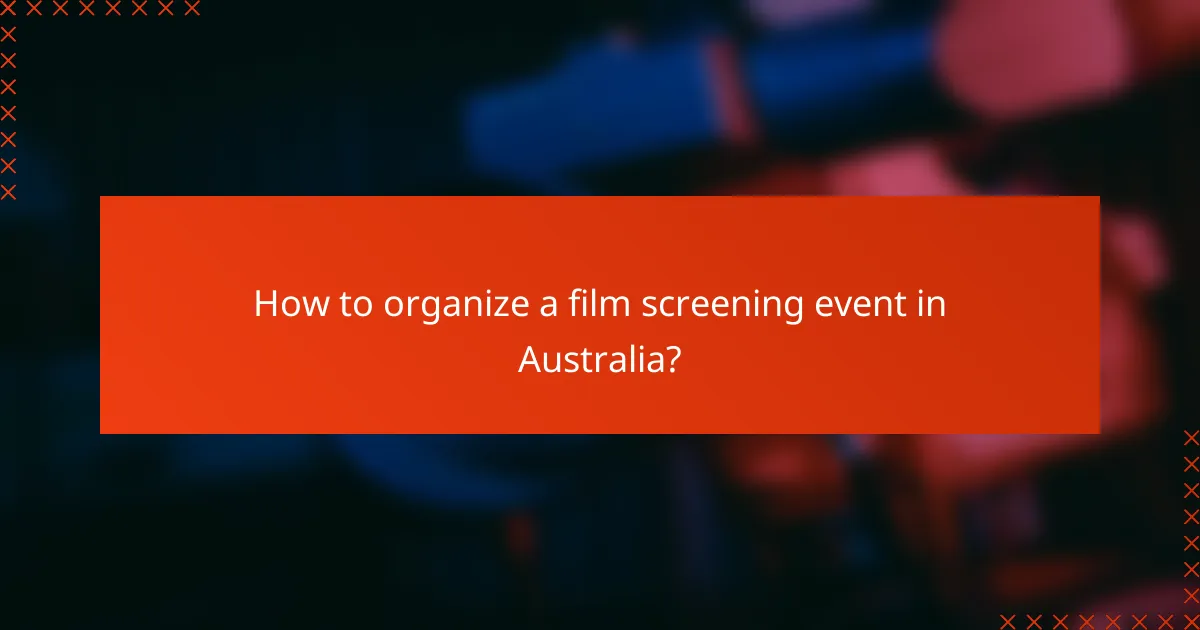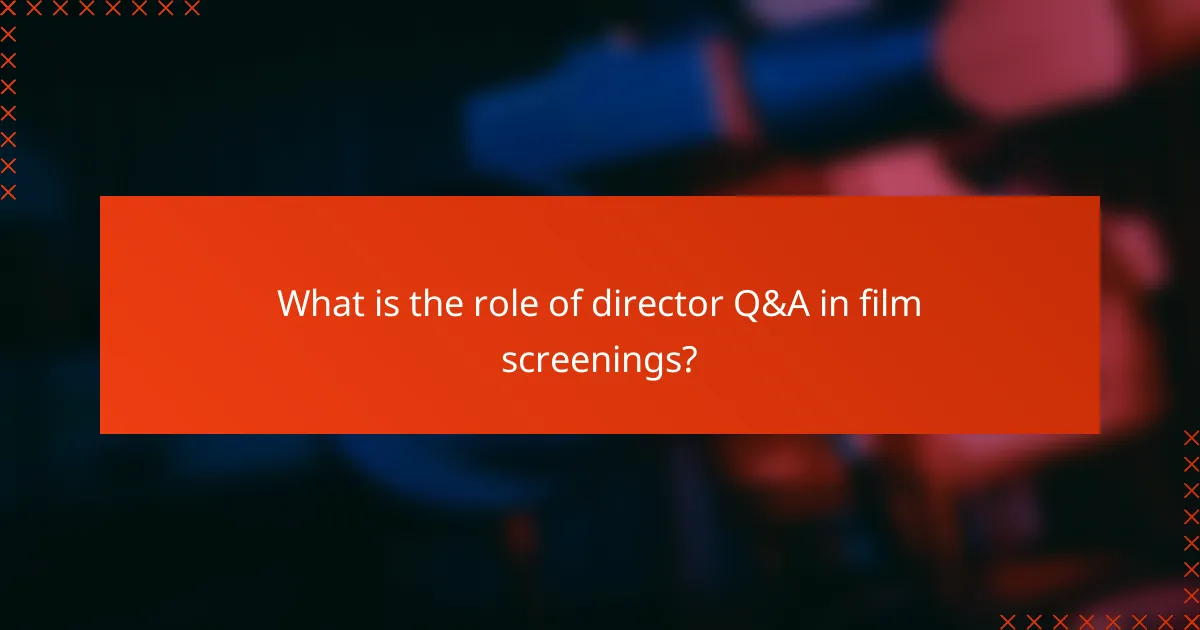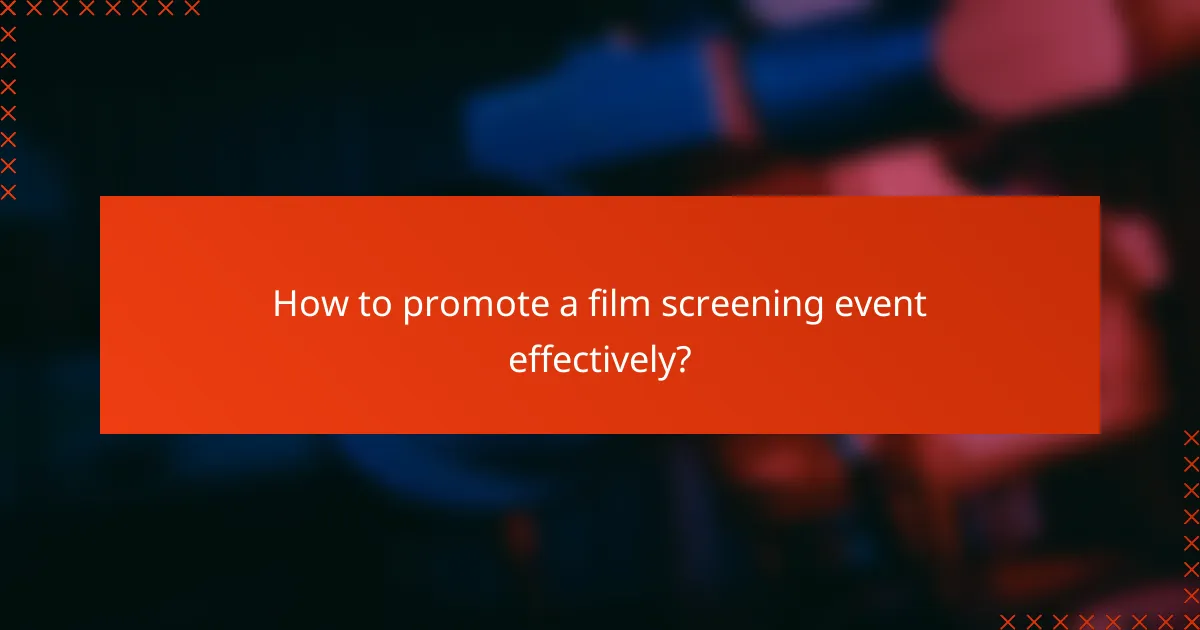Join us for an exciting film screening event featuring premiere showings that promise heightened excitement and direct audience interaction. This unique opportunity allows filmmakers to connect with viewers, enhancing the overall experience through engaging discussions and a director Q&A session. Don’t miss the chance to be part of a dynamic viewing experience that fosters valuable feedback and connection with the creative process.

How to organize a film screening event in Australia?
Organizing a film screening event in Australia involves careful planning, from selecting the right venue to ensuring compliance with local regulations. Key elements include audience engagement strategies, securing necessary permits, and managing your budget effectively.
Venue selection in major Australian cities
Choosing the right venue is crucial for a successful film screening. Major cities like Sydney, Melbourne, and Brisbane offer various options, including cinemas, community halls, and outdoor spaces. Consider factors such as capacity, accessibility, and technical facilities when selecting a venue.
For instance, a popular choice in Sydney is the Event Cinemas chain, which provides advanced screening technology and comfortable seating. Alternatively, Melbourne’s Federation Square offers a unique outdoor setting, ideal for summer screenings.
Permits and regulations for public screenings
In Australia, public film screenings typically require a public performance license, which can be obtained from the film’s distributor. Ensure you start this process early, as it may take time to secure the necessary permissions.
Additionally, check local council regulations regarding noise levels and crowd control, especially for outdoor events. Some councils may have specific requirements that could impact your event planning.
Budgeting for film screening events
Budgeting is essential for organizing a film screening event. Consider costs such as venue rental, licensing fees, marketing, and equipment rental. A small community screening might range from a few hundred to a couple of thousand Australian dollars, depending on the scale.
To manage your budget effectively, create a detailed list of expected expenses and potential income sources, such as ticket sales or sponsorships. This will help you identify areas where you can cut costs or need to invest more for a better experience.

What are the benefits of premiere showings?
Premiere showings offer unique advantages, including heightened excitement and the opportunity for direct audience interaction. These events create a platform for filmmakers to connect with viewers, enhancing the overall experience and generating valuable feedback.
Exclusive audience engagement opportunities
Premiere showings often feature interactive elements, such as live Q&A sessions with directors and cast members. This direct engagement allows audiences to ask questions and gain insights into the filmmaking process, fostering a deeper connection to the film.
Additionally, these events may include meet-and-greet opportunities, where fans can interact with the creators and actors. Such personal interactions can enhance viewer loyalty and create lasting memories associated with the film.
Increased media coverage and buzz
Hosting a premiere can significantly boost media attention and public interest in a film. Journalists and influencers often attend these events, providing coverage that can reach a wide audience through various platforms.
The excitement generated by a premiere can lead to increased social media chatter, which is crucial for marketing. Engaging content, such as behind-the-scenes footage or interviews shared during the event, can amplify this buzz and attract more viewers upon the film’s general release.

How to facilitate audience interaction during screenings?
Facilitating audience interaction during screenings enhances engagement and creates a more dynamic viewing experience. Incorporating tools like live polls and interactive Q&A sessions can significantly enrich the audience’s connection to the film and its creators.
Live polls and audience feedback
Live polls allow audiences to express their opinions in real-time, making them feel involved in the screening. Consider using mobile apps or web platforms that enable quick responses, such as Slido or Poll Everywhere, which can be set up to gather feedback on various aspects of the film.
To maximize participation, keep polls simple and relevant, focusing on key themes or scenes from the film. For example, ask viewers to rate their favorite character or predict the film’s outcome. This not only encourages interaction but also provides valuable insights for filmmakers.
Interactive Q&A sessions with filmmakers
Interactive Q&A sessions provide a platform for the audience to engage directly with filmmakers, enhancing their understanding of the film’s context and creative process. Schedule these sessions immediately after the screening to maintain audience interest and excitement.
Promote the Q&A in advance to encourage questions from the audience. You can collect questions via social media or during the screening through a designated app. This approach ensures that the discussion is relevant and addresses the viewers’ curiosities, making the experience more memorable.

What is the role of director Q&A in film screenings?
The director Q&A during film screenings serves as a platform for audiences to engage directly with the filmmaker, enhancing their understanding of the film’s themes and creative choices. This interaction allows viewers to gain insights into the filmmaking process and the director’s vision, fostering a deeper appreciation for the work presented.
Enhancing viewer understanding of the film
Director Q&As provide valuable context that can illuminate complex narratives or artistic decisions made during production. By explaining their intentions, directors can clarify elements that may not be immediately apparent, such as symbolism or character motivations.
For instance, a director might discuss specific scenes that were altered during editing, which can help audiences understand the final product better. This exchange often leads to a richer viewing experience, as attendees leave with a more nuanced perspective on the film.
Building a connection between audience and creators
Q&As create an opportunity for audiences to connect personally with the filmmakers, fostering a sense of community around the film. This interaction can humanize the creative process, making it relatable and accessible to viewers.
When directors share personal anecdotes or challenges faced during production, it can resonate with the audience, making the film feel more intimate. Engaging in this dialogue can also encourage viewers to support future projects from the director, as they feel a personal investment in their work.

What equipment is needed for a successful screening?
A successful screening requires a combination of audio-visual equipment, comfortable seating, and effective audience engagement tools. Key items include a high-quality projector, sound system, and seating arrangements that enhance the viewing experience.
Audio-visual setup requirements
For an effective audio-visual setup, start with a reliable projector that supports at least 1080p resolution for clear image quality. Consider the size of the screen in relation to the room; a common guideline is to have the screen width be about one-third of the distance from the screen to the furthest seat.
Sound quality is equally important. Invest in a surround sound system or high-quality speakers to ensure that dialogue and sound effects are clear and immersive. Test the audio levels before the event to avoid issues during the screening.
Seating arrangements for optimal viewing
Seating should be arranged to provide an unobstructed view of the screen from all angles. A tiered seating layout can enhance visibility, especially in larger venues. If using standard seating, ensure that rows are spaced adequately to allow for easy movement and comfort.
Consider the number of attendees when planning the layout. For smaller screenings, a more intimate setup with fewer seats can foster audience interaction. For larger events, ensure that seating is organized in a way that maintains a good sightline to the screen while accommodating social distancing if necessary.

How to promote a film screening event effectively?
To promote a film screening event effectively, leverage a mix of digital marketing strategies and community engagement. Focus on reaching your target audience through social media, local influencers, and interactive elements that enhance the viewing experience.
Utilizing social media platforms
Social media platforms are essential for promoting film screening events. Create engaging content that highlights the film, such as trailers, behind-the-scenes footage, and interviews with the cast or crew. Use platforms like Facebook, Instagram, and Twitter to reach different demographics.
Consider running targeted ads to reach specific audiences based on their interests and location. For example, you might promote the event to users who follow similar films or genres. Engaging with your audience through polls, countdowns, and giveaways can also increase excitement.
Collaborating with local influencers
Partnering with local influencers can significantly boost your film screening’s visibility. Identify influencers who align with the film’s themes or target audience and invite them to attend the screening. Their endorsement can attract their followers and create buzz around the event.
Provide influencers with exclusive content or experiences, such as a meet-and-greet with the director or cast. This not only enhances their engagement but also encourages them to share their experiences on their platforms, reaching a broader audience.

What are best practices for post-screening discussions?
Effective post-screening discussions enhance audience engagement and provide valuable insights into the film. Best practices include creating a welcoming environment, encouraging diverse opinions, and facilitating a structured dialogue.
Encouraging Audience Participation
To foster audience participation, start by inviting questions and comments immediately after the screening. Use open-ended prompts to stimulate discussion, such as asking what themes resonated most or how viewers interpreted specific scenes.
Consider using tools like audience response systems or social media platforms to gather real-time feedback. This can help shy participants feel more comfortable sharing their thoughts and ensure a variety of perspectives are heard.
Structuring the Discussion
Structure is key to a productive discussion. Begin with a brief recap of the film’s main points, then transition into thematic discussions. Allocate time for each segment to keep the conversation focused and engaging.
For example, you might dedicate the first 10 minutes to the film’s narrative, followed by 5 minutes on character development. This approach helps maintain momentum and ensures all relevant topics are covered.
Incorporating the Director Q&A
Including a director Q&A can greatly enrich the discussion. Prepare the director with potential questions in advance, focusing on their creative choices and challenges faced during production. This not only provides insight but also personalizes the experience for the audience.
Encourage the audience to submit questions beforehand or during the screening. This can lead to a more dynamic interaction and ensure that the most pressing inquiries are addressed.



